Novel Advanced Composite Bamboo Structural Members with Bio-Based and Synthetic Matrices for Sustainable Construction
Abstract
1. Introduction
2. Literature Review
3. Materials and Experimental Methodology
- Behaviour of different bio-based and synthetic matrices in bamboo-based composite members using full and split bamboo culms.
- Influence of the confinement on the failure mode and compressive strength of FCB and SCB sections.
3.1. Description of Materials and Specimens
3.2. Specimen Fabrication
3.3. Experimental Testing Methodology
4. Results
4.1. Failure Mode
4.2. Displacement Response
4.3. Strain Response
5. Discussions
5.1. Axial Ductility and Stiffness
5.2. Absorbed Energy
5.3. Prediction of the Axial Capacity
6. Conclusions
- The proposed bamboo-composite systems, except for that of SCB-GRT-H specimen, can significantly enhance the compressive strength of bamboo columns when compared to the non-composite control specimen. In this study, the average gain in compressive capacity reaches 42.4% for bamboo and furan composite columns. The full culm bamboo and gout composite specimen reached 48.4% gain, whereas, the split culm bamboo and gout composite specimen failed to provide any gain in compressive capacity due to improper composted action between split bamboo and grout. The gain in the specimen with an epoxy matrix and improved confinement was the remarkable value of 294.4%.
- The furan-based specimens presented an excellent recovery characteristic by almost returning from their extremely bent shape with 34° rotation of the longitudinal axis at the ultimate to a residual 4° out of straightness after the load was removed.
- The SCB-FRN-H represented the greatest amount of ductility between the tested specimens in terms of DI with ductility index equal to 1.58. The FCB-EPX-I did not represent ductile behaviour and failed in a brittle manner.
- The control specimen reached the greatest specified ductility index considering its lighter weight compared to other specimens (SDI = 0.97 1/kg). Among the composite specimens, the SCB-FRN-H reached the greatest SDI equal to 0.64 1/kg, which was due to its ductile behaviour and rather lightweight.
- Among the tested specimens, the FCB-GRT-H was the specimen, which represented the greatest axial stiffness with a 73% increase in the axial stiffness increase over the control column. The specimen SCB-GRT-H showed the lowest axial stiffness which corresponded to a 29% decrease in the axial ductility when compared to the control specimen.
- The specimen with the greatest amount of endured energy was the FCB-EPX-H with AE equal to 4634.0 J. The specimen with the least amount of energy absorption was the control specimen with AE equal to 986.2 J.
- The two specimens with the greatest specified absorbed energy were FCB-EPX-H and FCB-FRN-H specimens with 1.18 J/gr and 0.90 J/gr, respectively. Considering the rather heavyweight of the grout-based specimens, they represented the least amount of SAE among all specimens, i.e., 0.41 J/gr and 0.17 J/gr for FCB-GRT-H and SCB-GRT-H, correspondingly.
Author Contributions
Funding
Acknowledgments
Conflicts of Interest
References
- Ogendal, A.S. Large-Deformation Behaviour of Thermoplastics at Various Stress States: An Experimental and Numerical Study. Ph.D. Thesis, Norwegian University of Science and Technology, Trondheim, Norway, 2012. [Google Scholar]
- Javadian, A.; Wielopolski, M.; Smith, I.F.C.; Hebel, D.E. Bond-behavior study of newly developed bamboo-composite reinforcement in concrete. Constr. Build. Mater. J. 2016, 122, 110–117. [Google Scholar] [CrossRef]
- United Nations World Urbanization Prospects. Department of Economic and Social Affairs, Population Division; The 2018 Revision Technical Report; United Nations World Urbanization Prospects: New York, NY, USA, 2018. [Google Scholar]
- van der Lugt, P. Design Interventions for Stimulating Bamboo Commercialization: Dutch Design Meets Bamboo as a Replicable Model. Ph.D. Thesis, Delft University of Technology, Delft, The Netherlands, 2008. [Google Scholar]
- Dowling, D.A.; Ramakrishnan, V. Green Gas Removal; Royal Society and Royal Academy of Engineering: London, UK, 2018. [Google Scholar]
- United Nations Environment Global Status Report. Towards a Zero-Emission, Efficient, and Resilient Buildings and Construction Sector; United Nations Environment Global Status Report: Nairobi, Kenya, 2017. [Google Scholar]
- Nunes, L. Nonwood bio-based materials. In Performance of Bio-Based Building Materials; Jones, D., Brischke, C., Eds.; Elsevier: Amsterdam, The Netherlands, 2017; pp. 97–186. [Google Scholar]
- Hidalgo, H.G.; Amador, J.A.; Alfaro, E.J.; Quesada, B. Hydrological climate change projections for Central America. J. Hydrol. 2013, 495, 94–112. [Google Scholar] [CrossRef]
- Bystriakova, N.; Kapos, V.; Stapleton, C.; Lysenko, I. Bamboo Biodiversity: Information for Planning Conservation and Management in the Asia-Pacific Region; Unep-Wcmc/Inbar: Beijing, China, 2003. [Google Scholar]
- Wysocki, W.P.; Clark, L.G.; Attigala, L.; Ruiz-Sanchez, E.; Duvall, M.R. Evolution of the bamboos (Bambusoideae; Poaceae): A full plastome phylogenomic analysis. BMC Evol. Biol. 2015, 15. [Google Scholar] [CrossRef]
- Clark, L.G. Bambusoideae in Poaceae, in Longhi-Wagner H (Editor) Flora Fanerogâmica do Estado de São Paulo, Volume I, [Includes collaboration with Londoño X, (Eremocaulon, Guadua), Longhi-Wagner H, and de Oliveira RP, (Olyra, Parodiolyra), and Sendulsky T, (Merostachys); Hucitec: São Paulo, Brazil, 2001; pp. 21–49. [Google Scholar]
- Trujillo, D.J.A.; Lopez, L. Bamboo material characterisation. In Nonconventional and Vernacular Construction Materials; Harries, K.A., Sharma, B., Eds.; Elsevier: Amsterdam, The Netherlands, 2016; pp. 365–392. [Google Scholar]
- Zea Escamilla, E.; Habert, G. Regionalizing the environmental impact of bamboo-based buildings by integrating life cycle assessment with geographic information systems: A comparative case-study in Colombia. In Proceedings of the 10th World Bamboo Congress, Damyang, Korea, 17–22 September 2015. [Google Scholar]
- Akwada, D.R.; Akinlabi, E. Bamboo use in Construction Industry: How Sustainable is it? In Proceedings of the DII-2015 Conference on Infrastructure Development and Investment Strategies for Africa, Livingstone, Zambia, 16–18 September 2015. [Google Scholar]
- Osorio, L.; Trujillo, E.; Van Vuure, A.; Verpoest, I. Morphological aspects and mechanical properties of single bamboo fibres and flexural characterization of bamboo/epoxy composites. J. Reinf. Plast. Compos. 2011. [Google Scholar] [CrossRef]
- Wang, F.; Shao, J.; Keer, L.M.; Li, L.; Zhang, J. The effect of elementary fibre variability on bamboo fibre strength. Mater. Des. J. 2015, 75, 36–142. [Google Scholar] [CrossRef]
- Sukmawan, R.; Takagi, H.; Nakagaito, A.N. Strength evaluation of cross-ply green composite laminates reinforced by bamboo fiber. Compos. Part B 2016, 84, 9–16. [Google Scholar] [CrossRef]
- Sharma, B.; Gatóo, A.; Bock, M.; Ramage, M. Engineered bamboo for structural applications. Constr. Build. Mater. 2015, 81, 66–73. [Google Scholar] [CrossRef]
- Trujillo, D.J.A.; Malkowska, D. Empirically derived connection design properties for Guadua bamboo. Constr. Build. Mater. 2018, 163, 9–20. [Google Scholar] [CrossRef]
- Chung, K.F.; Yu, W.K. Mechanical properties of structural bamboo for bamboo scaffoldings. Eng. Struct. 2002, 24, 429–442. [Google Scholar] [CrossRef]
- Lobovikov, M.; Paudel, S.; Piazza, M.; Ren, H.; Wu, J. World Bamboo Resources: A Thematic Study Prepared in the Framework of the Global Forest Resources Assessment 2005; Food and Agriculture Organisation of the United Nations (FAO): Rome, Italy, 2007; p. 75. [Google Scholar]
- Sharma, B.; Gatóo, A.; Bock, M.; Mulligan, H.; Ramage, M. Engineered bamboo: State of the art. Proc. Inst. Civil Eng. 2014. [Google Scholar] [CrossRef]
- Xiao, Y.; Zhou, Q.; Shan, B. Design and construction of modern bamboo bridges. J. Bridge Eng. 2010, 15, 533–541. [Google Scholar] [CrossRef]
- Ghavami, K.; Garcia, J. Building with Bamboo. Inst. Civil Eng. Available online: https://www.ice.org.uk/news-and-insight/the-civil-engineer/march-2017/building-with-bamboo (accessed on 12 September 2019).
- Shen, L.; Yang, J.; Zhang, R.; Shao, C.; Song, X. The benefits and barriers for promoting bamboo as a green building material in China—An integrative analysis. Sustainability 2019, 11, 2493. [Google Scholar] [CrossRef]
- Harries, K.A.; Sharma, B.; Richard, M.J. Structural use of full culm bamboo: The path to standardization. Int. J. Arch. Eng. Constr. 2012, 1, 66–75. [Google Scholar] [CrossRef]
- Sharma, B.; Gatóo, A.; Ramage, M. Effect of processing methods on the mechanical properties of engineered bamboo. Constr. Build. Mater. 2015, 83, 95–101. [Google Scholar] [CrossRef]
- Harries, K.A.; Bumstead, J.; Trujillo, D.J.A. Geometric and material effects on bamboo buckling behaviour. In Structures and Building—Proceedings of the Institution of Civil Engineers the Institution of Civil Engineers; Institution of Civil Engineers: London, UK, 2016; p. 33. [Google Scholar]
- Huang, Z.; Sun, Y.; Musso, F. Assessment of bamboo application in building envelope by comparison with reference timber. Constr. Build. Mater. 2017, 156, 844–860. [Google Scholar] [CrossRef]
- ISO 22157 Bamboo Structures—Determination of Physical and Mechanical Properties of Bamboo Culms—Test Methods; International Organization for Standardization: Geneva, Switzerland, 2019; p. 32.
- Dixon, P.G.; Gibson, L.J. The structure and mechanics of moso bamboo material. J. R. Soc. Interface 2014, 11, 20140321. [Google Scholar] [CrossRef] [PubMed]
- Lo, T.Y.; Cui, H.Z.; Leung, H.C. The effect of fiber density on strength capacity of bamboo. Mater. Lett. 2004, 58, 2595–2598. [Google Scholar] [CrossRef]
- Schmitt, C.R. Polyfurfuryl alcohol resins. Polym. Plast. Technol. Eng. 2008, 3, 121–158. [Google Scholar] [CrossRef]
- Foruzanmehr, M.; Elkoun, S.; Fam, A.; Robert, M. Degradation characteristics of new bio-resin based-fiber-reinforced polymers for external rehabilitation of structures. J. Compos. Mater. 2015. [Google Scholar] [CrossRef]
- Tumolva, T.; Kubouchi, M.; Sakai, T. Evaluating the carbon storage potential of furan resin-based green composites. In Proceedings of the 17th International Conference on Composite Materials, Edinburgh, UK, 27–31 July 2009. [Google Scholar]
- Crossley, R.; Schubel, P.; Stevenson, A.; Moreira, M. The development and processing of a sustainable fully bio- derived polyfurfuryl alcohol matrix flax fibre prereg. In Proceedings of the ECCM15-15th European Conference on Composite Materials, Venezia, Italy, 24–28 June 2012. [Google Scholar]
- Czifrák, K.; Lakatos, C.; Karger-Kocsis, J.; Daróczi, L.; Zsuga, M.; Kéki, S. One-pot synthesis and characterization of novel shape-memory poly(ε-Caprolactone) based polyurethane-epoxy co-networks with diels–alder couplings. Polymers 2018, 10. [Google Scholar] [CrossRef] [PubMed]
- Yekani Fard, M. Nonlinear Inelastic Mechanical Behavior of Epoxy Resin Polymeric Materials. Ph.D. Thesis, Arizona State University, Tempe, AZ, USA, 2011; p. 192. [Google Scholar]
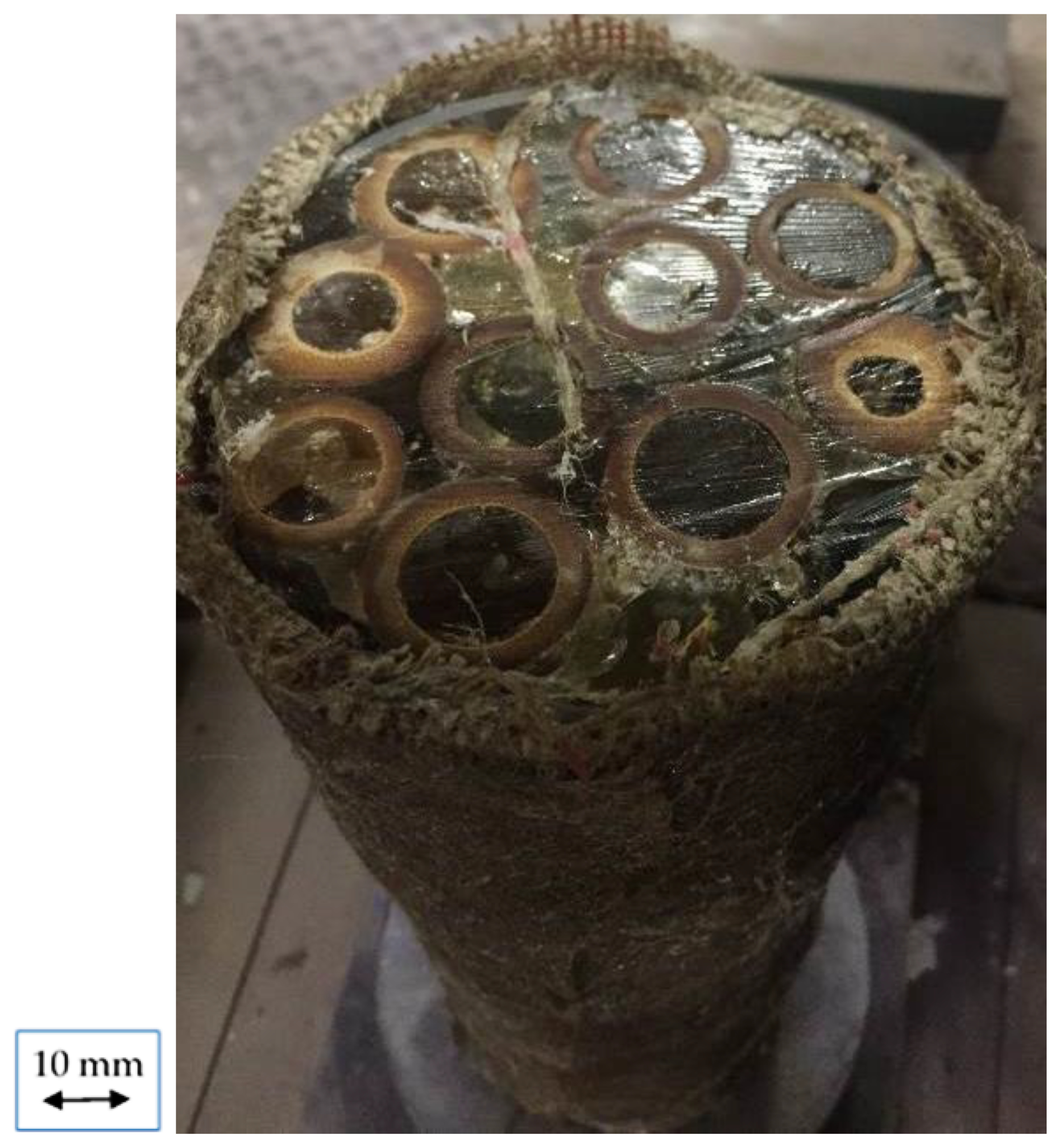


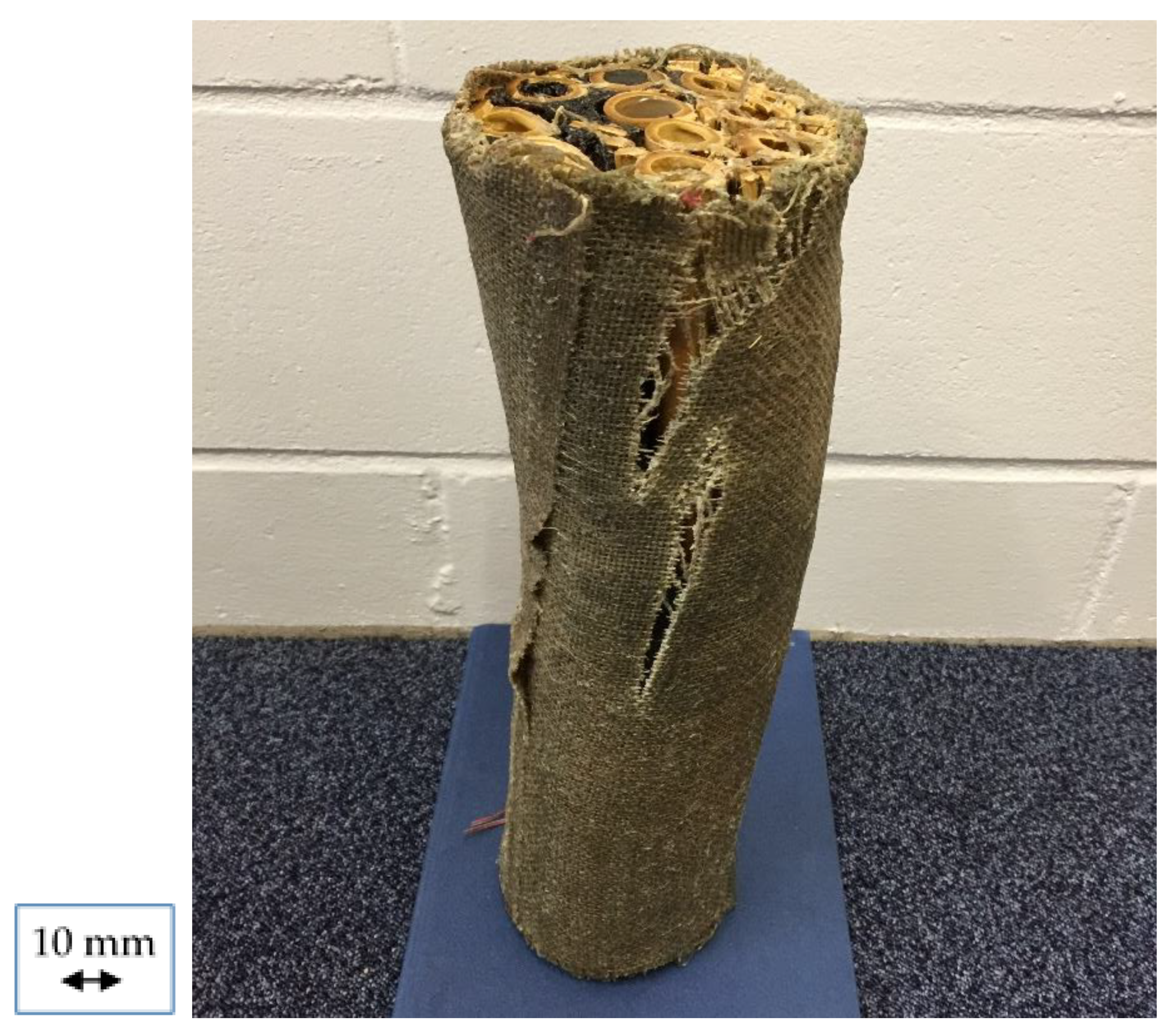
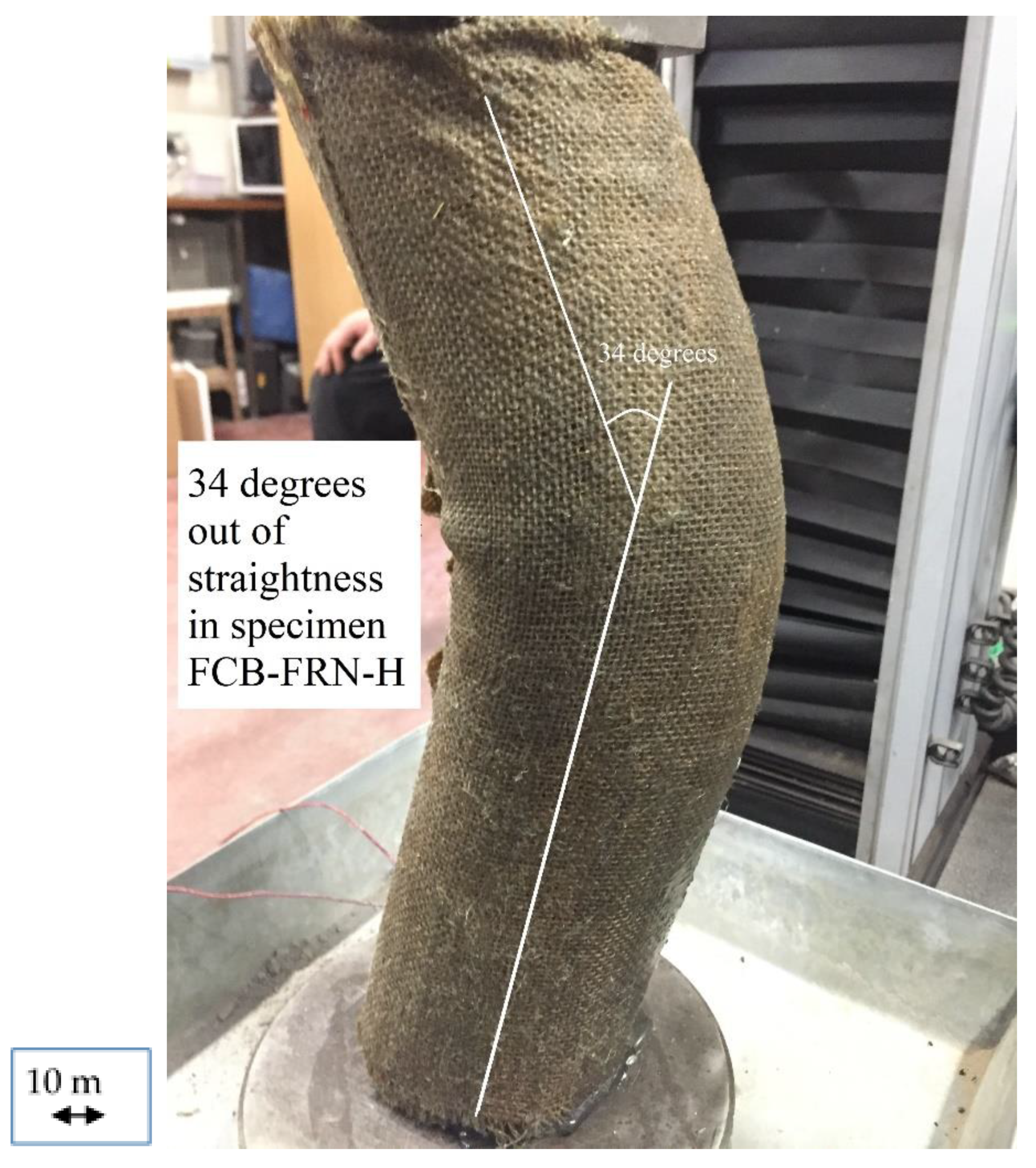


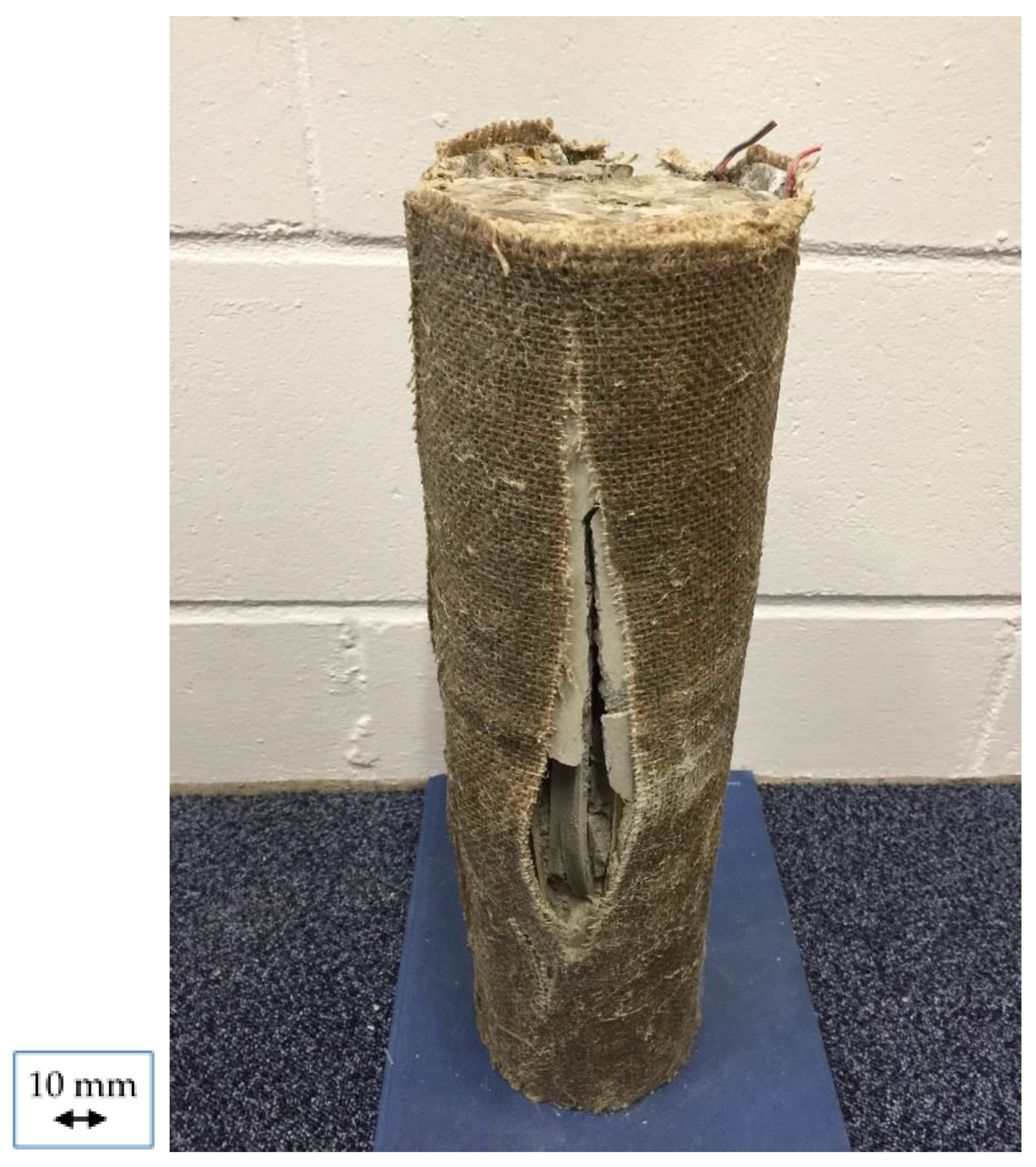
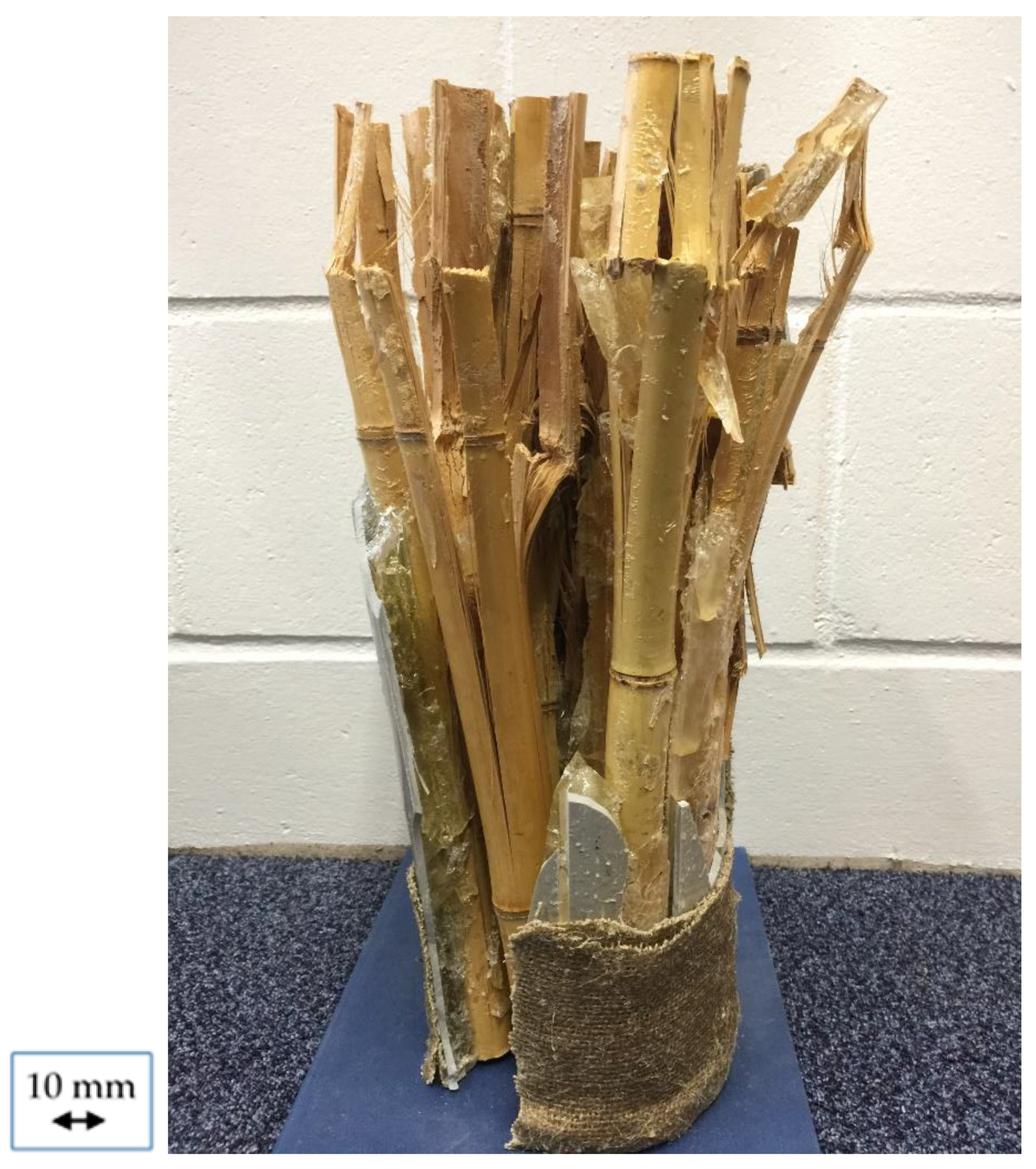
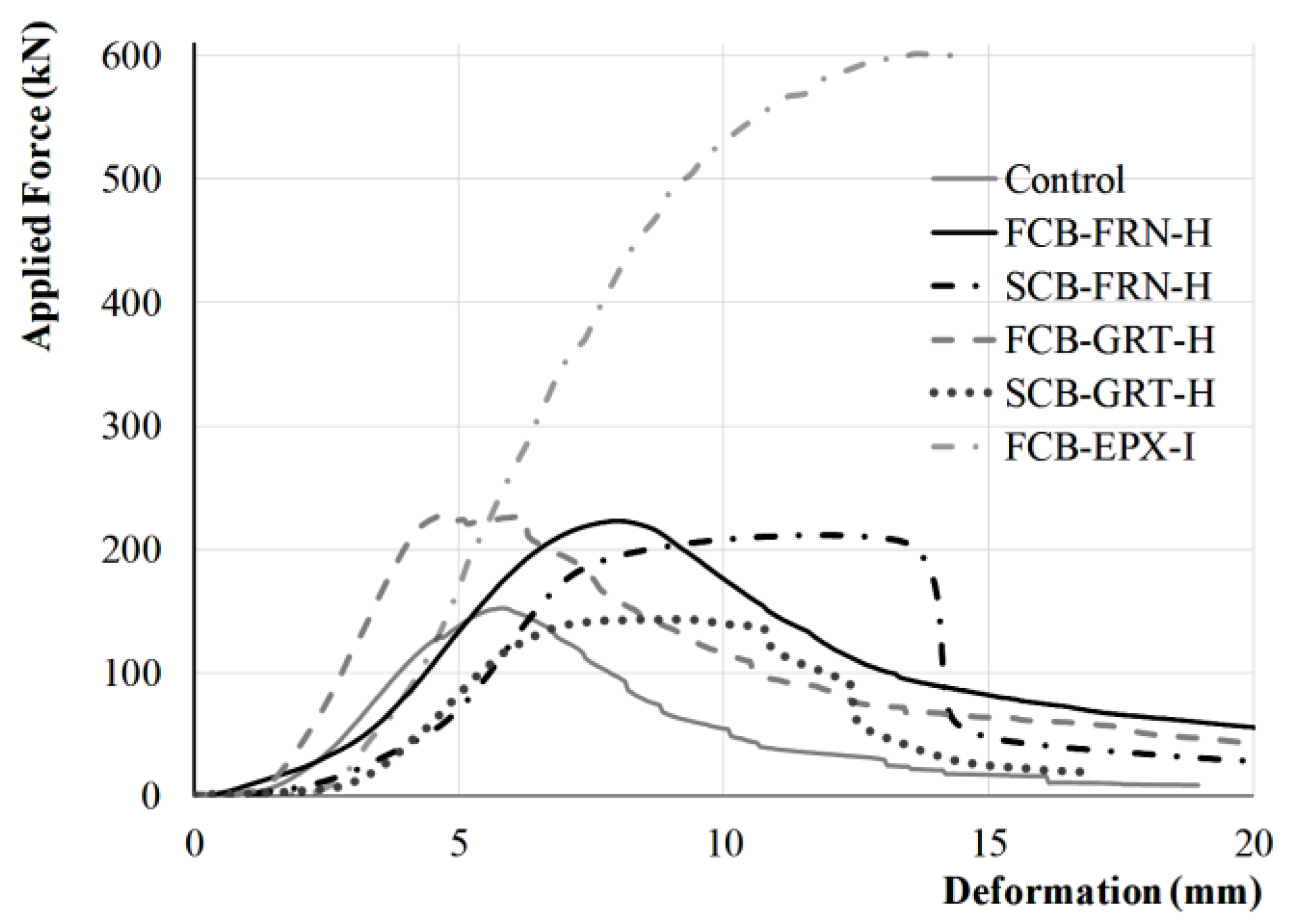
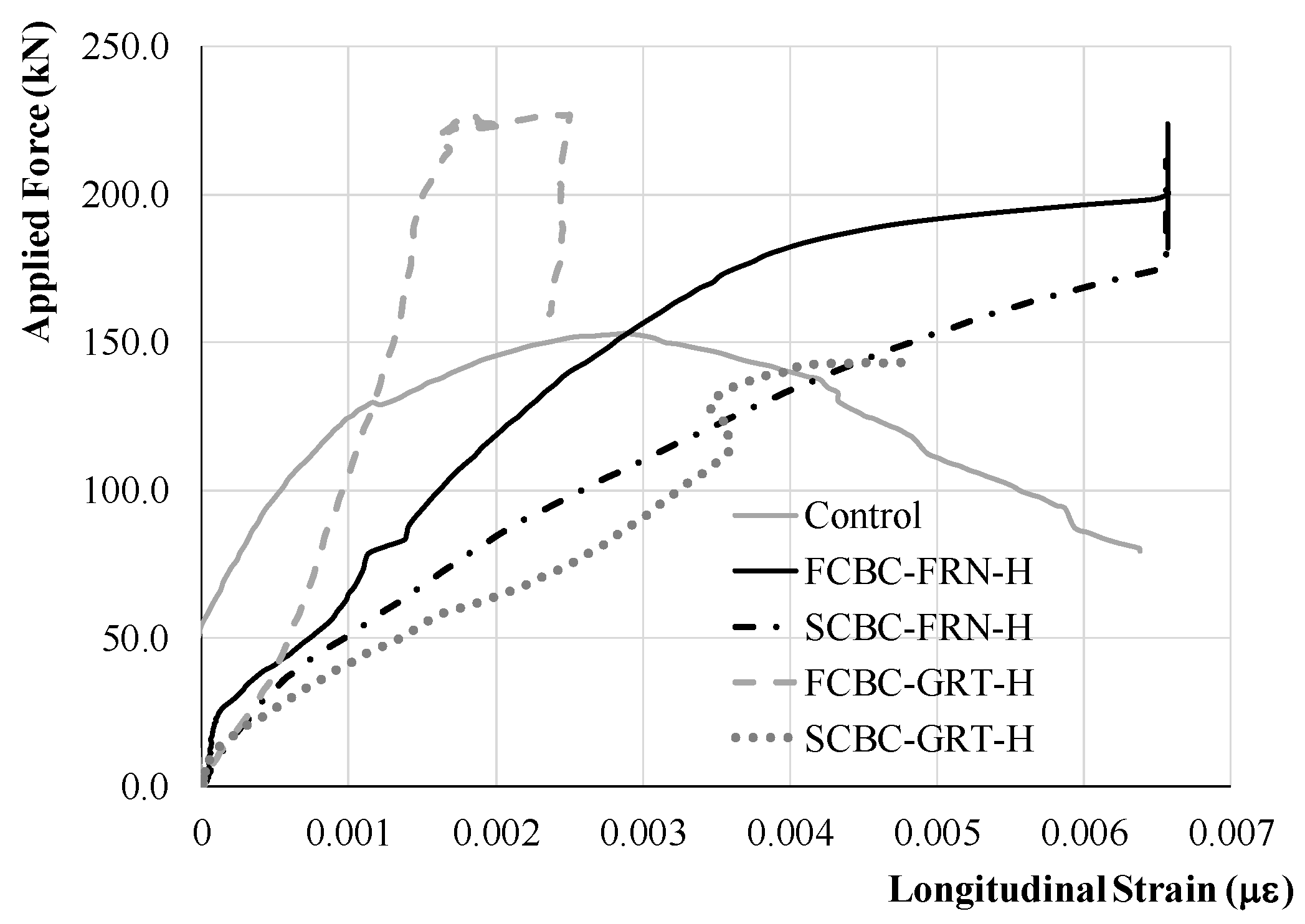
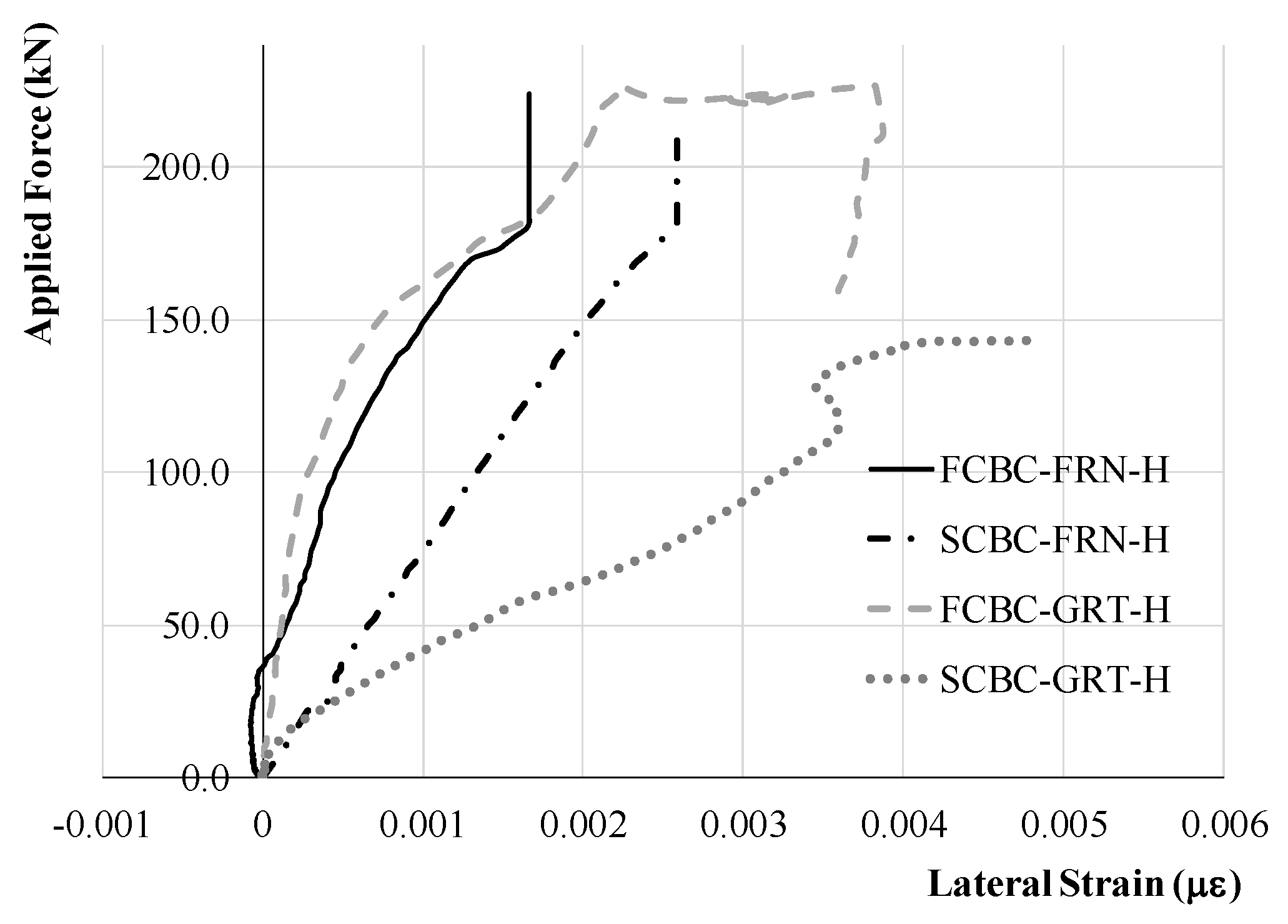
| Specimen | Load at Rupture (kN) | Area of Cross-Section (mm2) | End Shortening at Peak (mm) | Axial Stress (MPa) | Density of Specimen (kg/m3) | Gain (%) | Capacity Overweight (kN/kN) | Mode of Failure |
|---|---|---|---|---|---|---|---|---|
| Control | 152.4 | 2764.6 | 5.75 | 55.1 | 1147.3 | − | 12323 | Splitting of bamboo |
| FCB-FRN-H | 223.3 | 8332.3 | 7.95 | 26.8 | 938.4 | 46.5 | 7291 | Buckling of specimen |
| SCB-FRN-H | 210.8 | 8332.3 | 13.31 | 25.3 | 742.9 | 38.3 | 8695 | Buckling of specimen |
| FCB-GRT-H | 226.1 | 8332.3 | 6.25 | 27.1 | 1670.2 | 48.4 | 4148 | Splitting of matrix |
| SCB-GRT-H | 143.3 | 8332.3 | 10.85 | 17.2 | 2049.5 | − | 2142 | Loss of composite action |
| FCB-EPX-I | 601.1 | 8332.3 | 13.82 | 72.1 | 1174.5 | 294.4 | 15681 | Compressive Crushing |
| Specimen | Bamboo Shape | Matrix | Confinement |
|---|---|---|---|
| Control | Full culm | - | - |
| FCB-FRN-H | FCB | Furan-based | Hemp |
| SCB-FRN-H | SCB | Furan-based | Hemp |
| FCB-GRT-H | FCB | Grout | Hemp |
| SCB-GRT-H | SCB | Grout | Hemp |
| FCB-EPX-I | FCB | Epoxy | Improved |
| Specimen | Ductility Index mm/mm | Specified Ductility 1/kg | Axial Stiffness kN/mm | Absorbed Energy kN·mm | Specified Absorbed Energy kN·mm/gr |
|---|---|---|---|---|---|
| Control | 1.22 | 0.97 | 27.2 | 986.2 | 0.78 |
| FCB-FRN-H | 1.26 | 0.40 | 29.5 | 2811.8 | 0.90 |
| SCB-FRN-H | 1.58 | 0.64 | 23.9 | 2096.6 | 0.85 |
| FCB-GRT-H | 1.47 | 0.26 | 47.1 | 2298.4 | 0.41 |
| SCB-GRT-H | 1.46 | 0.21 | 19.2 | 1177.1 | 0.17 |
| FCB-EPX-I | 0 | 0 | 30.3 | 4634.0 | 1.18 |
| Specimen | Bamboo Volume Ratio (%) | Theoretical Strain of First Component to Break (strain) | Measured Strain of Bamboo at Peak (strain) | Experimental Failure Load (kN) | Theoretical Failure Load (kN) | Pexp/Ptheory |
|---|---|---|---|---|---|---|
| Control | 100 | 0.0052 | 0.0031 | 152.4 | 155.1 | 0.98 |
| FCB-FRN-H | 33 | 0.0052 | 0.0065 | 223.3 | 245.5 | 0.91 |
| SCB-FRN-H | 33 | 0.0052 | 0.0065 | 210.8 | 245.5 | 0.86 |
| FCB-GRT-H | 33 | 0.0035 | 0.0025 | 226.1 | 208.4 | 1.08 |
| SCB-GRT-H | 33 | 0.0052 | 0.0048 | 143.3 | 152.3 | 0.94 |
| FCB-EPX-I | 32 | 0.0052 | 0.0058 | 601.1 | 824.4 | 0.73 |
© 2020 by the authors. Licensee MDPI, Basel, Switzerland. This article is an open access article distributed under the terms and conditions of the Creative Commons Attribution (CC BY) license (http://creativecommons.org/licenses/by/4.0/).
Share and Cite
Mofidi, A.; Abila, J.; Ng, J.T.M. Novel Advanced Composite Bamboo Structural Members with Bio-Based and Synthetic Matrices for Sustainable Construction. Sustainability 2020, 12, 2485. https://doi.org/10.3390/su12062485
Mofidi A, Abila J, Ng JTM. Novel Advanced Composite Bamboo Structural Members with Bio-Based and Synthetic Matrices for Sustainable Construction. Sustainability. 2020; 12(6):2485. https://doi.org/10.3390/su12062485
Chicago/Turabian StyleMofidi, Amir, Judith Abila, and Jackson Tsz Ming Ng. 2020. "Novel Advanced Composite Bamboo Structural Members with Bio-Based and Synthetic Matrices for Sustainable Construction" Sustainability 12, no. 6: 2485. https://doi.org/10.3390/su12062485
APA StyleMofidi, A., Abila, J., & Ng, J. T. M. (2020). Novel Advanced Composite Bamboo Structural Members with Bio-Based and Synthetic Matrices for Sustainable Construction. Sustainability, 12(6), 2485. https://doi.org/10.3390/su12062485





